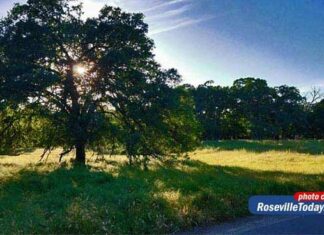Rocklin, Calif. – The Rocklin Historical Society is restoring a 124 year old church on Front Street in downtown Rocklin. When RHS completes the restoration in September 2007, the church will be primarily a non-denominational wedding chapel.
Gold Rush era Bishop Joseph Alemany of the San Francisco Catholic Archdiocese dedicated the church as Saint Mary’s of the Assumption in 1883. The Catholics abandoned the building in 1983 because it was too small and it was fraying with age.
In November 2006, Gerry Lyons and Robb McLean of Wave Broadband were in the church interviewing Gene Johnson, the restoration’s project manager. While Johnson talked Lyons reached into the construction litter on a nearby table and picked up an 8′ x 10′ rectangular piece of gray marble which Johnson had found when demolition for the restoration started in September 2005.
Lyons noticed the barely visible words ‘Sacret (sic) Heart Church’ scribbled across one side. He turned the stone over and noticed a compartment plugged with a matchbox-size piece of marble and sealed with resin. From his days as an altar boy in Brooklyn, New York Lyons realized that he had picked up an altar stone.
According to the historical archivist for the Sacramento Diocese, Jesuit William Breault, in the Catholic tradition altar stones were sacred blocks of stone, usually marble, embedded in the top of every Catholic Church altar. Each stone included a reliquary that contained the relic of a saint, usually a piece of bone or other body part, sometimes wrapped in lead foil.
In the 1960s Catholic Church law changed the configuration of church altars and eliminated the need for altar stones. Workmen remodeling Saint Mary’s altar to conform to the new law in the 1960’s or 1970’s possibly set the Sacred Heart Church altar stone aside in a remote nook where it rested until Johnson started the restoration. It must have remained well out of sight because it went unnoticed by two Protestant congregations that occupied the church from the mid-1980s until the late 1990s.
But how did a Sacred Heart Church altar stone find its way into a church named Saint Mary’s of the Assumption. One plausible explanation goes back to the waning of the California Gold Rush in the 1860’s.
According to San Francisco Archdiocese records, the altar stone could have originated in a little known Sacred Heart Church which was located in the Ione valley in the 1850’s and early 1860s.(note 1.) That church closed in 1864 as the Gold Rush waned and Ione Valley Argonauts abandoned their sluice boxes in favor of employment on higher ground.
Catholic priest Patrick Walsh was active in the Ione area then, relocating Catholic schools and parishes as populations shifted. According to a Jesuit Historian (note 2), Alemany dispatched Walsh to Utah in 1869 to establish a Sacred Heart Church in Salt Lake City. Walsh might have taken the Ione Valley Sacred Heart Church altar stone to Salt Lake City with the intention of using it in his new church.
According to records of the Catholic Diocese of Salt Lake City, Walsh established Salt Lake City’s first Catholic Church in 1871 and named it Saint Mary Magdalene. Diocese records contain no mention of a Sacred Heart Church and there is no mention of Walsh in the Salt Lake City area before his connection with the Saint Mary Magdelene Church.
But where was Walsh from 1869 until 1871? Possibly he had built the Sacred Heart Church in Utah as Alemany directed in 1869 but failed to establish a viable parish in the midst of predominantly Mormon territory. If so, he would have lifted the Sacred Heart Church altar stone from the altar of his ill fated church and kept it, possibly expecting to use it later in another church building. Walsh next appears in the historical record back in California in 1873 as pastor of Immaculate Conception parish near Jackson, and later, in 1877, as an assistant to Alemany in San Francisco.
In 1882 Alemany directed Fr. John Leahy of Folsom to establish the Saint Mary’s of the Assumption church in Rocklin. And as construction on the new building was underway in 1883 Alemany’s assistant, Walsh, might have presented his much traveled altar stone to Leahy for the altar of his new church.
We may never know for sure the origin of Lyons’ find. But it could be a remnant of the Gold Rush era and the initial and now forgotten efforts to establish a Catholic church in Utah. Meanwhile the reliquary of the Saint Mary’s altar stone remains sealed and Johnson is preparing for an altar stone display on an interior wall of the remodeled Saint Mary’s church.
Notes:
1. Amador County historians say that the Sacred Heart Church now in Ione was unknown before 1867.
2. Hallowed Were the Gold Dust Trails, 1946, by Jesuit Henry Walsh,
(21+ years strong)
Welcome to the brighter side!
Get in front of local customers! 24/7 (365)





















